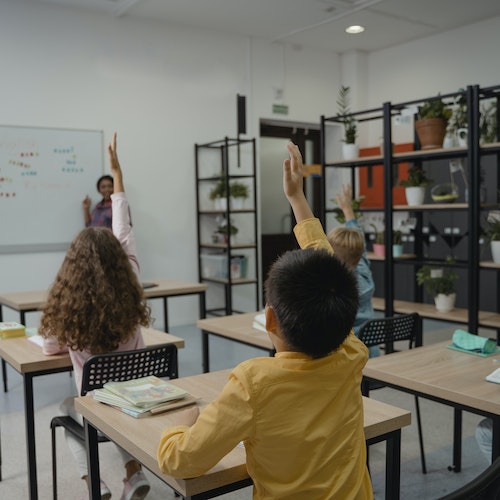
Is group showing the fate of schooling? How might schools handle the psychological well-being emergency exacerbated by the pandemic? Which job will computer based intelligence play in homerooms? We talked with training pioneers from the nation over, including the dignitaries of two educator universities, a secondary school head, specialists in EdTech, social and close to home learning, news proficiency, and that’s just the beginning. They share their estimate for schooling patterns in the year ahead.
Concerning HMH, we’re continuously pondering what’s on the horizon. President Jack Lynch predicts that instruction will turn out to be progressively super advanced and high-contact. His vision mixes the best of innovation with the best of the study hall experience. As Lynch wrote in TechCrunch, “We currently have the chance to take what we have realized and use it to introduce another period of schooling — one that is fueled to a significant degree by innovation yet focused on human association, and one where we reject the bogus decision between drawing in programming and a unimaginable educator.”
Prediction #1: Expect More AI-Embedded EdTech Solutions.
“As purchasers, we utilize man-made reasoning consistently without acknowledging it. For instance, you don’t consider your Netflix line computer based intelligence, yet it is. Exactly the same thing occurs in schooling. Simulated intelligence is progressively implanted in a wide range of EdTech arrangements. This sort of innovation can help educators in significant ways: It can save them time, measure understudy development, and customize educational plan for individual understudies. In its most encouraging structure, this isn’t about innovation supplanting people. It’s about people zeroing in on what they can show improvement over any endlessly machines taking on undertakings that they can do all around well. Despite the fact that it isn’t generally marked as “Artificial intelligence,” these days, people combined with progressively shrewd programming is becoming typical. The half breed future is here.”
Prediction #2: Team Teaching Is the Future Of Education.
“The one-educator, one-homeroom model isn’t feasible any longer. We shouldn’t acknowledge that new educators are most certainly going to be crying in their vehicle by the day’s end. That is absurd. Instructors can at this point not act like a lone ranger, given the wide inconsistencies across grade levels and the need to customize learning. Educators must work in groups. Envision a group of 2nd grade instructors working with 100 children. Rather than one educator attempting to show 30 children each subject, presently you have somebody in the group who has practical experience in math and another who represents considerable authority in perusing. There may be paraprofessionals in the group prepared in how to coordinate social-everyday encouragement and health. Local area volunteers could be mentors. Computer based intelligence improved innovation that gives information that can assist educators with fitting figuring out how to each youngster will likewise be a piece of the group. Collectively, we can bunch, re-gathering, and move goofs off, in light of what they need and as per our aptitude.”
Prediction #3: Social And Emotional Support For Teachers Is Increasing.
“There will be an uplifted spotlight on SEL for educators and staff. We’ll see locale concocting ways of offering that help, which is so basic at the present time. Come at the situation from an instructor’s perspective. They are overpowered, attempting to reproduce the study hall networks they had pre-Coronavirus, while they’re additionally expected to oversee truly broadening scholarly holes. They’re managing acts of mass violence, catastrophic events, and a pandemic with an immense loss of life. I can see locale investing a great deal of energy and exertion, in training and expert learning, to assist educators with adapting to these difficulties.”
Prediction #4: Look For a Rise In Alternative Assessments.
“As numerous schools and colleges end SAT necessities for confirmation, you can hope to see a continuous development away from state sanctioned testing as the prevailing method for understudy evaluation. Proceeding, states should give direction on the most proficient method to evaluate understudies, whether that is utilizing portfolio-based appraisal or a few different method. Any individual who is focusing knows that the pandemic created critical learning misfortune for some children. Testing them isn’t the method for tending to it. For some in the business, testing is all they know. They answer each arrangement of issues with a similar cure. Throughout the previous 20 years, we’ve been estimating children’s advancement by testing them. I’m trusting we’re entering a period where we’ll be more keen on testing children and taking advantage of their interest for realizing, where we’ll zero in on greatness in educating and making conditions that get kids amped up for learning.”
Prediction #5: Educators Will Address Conspiratorial Thinking.
“There’s an earnestness among instructors around how to address conspiratorial reasoning. At News Proficiency Undertaking, we don’t show paranoid fears. We center around the brain research behind conspiratorial reasoning: What is it about paranoid ideas that individuals see as convincing? What attracts them? What is the job of mental disharmony and mental predispositions? Kids are assaulted with tricks and falsehood. Web-based entertainment makes it more straightforward for these things to spread. Children could run over connivances due to calculations. On the off chance that individuals they’re associated with on Tik Tok watch a video promoting a scheme, the calculation could show it to them as well. So they could run over schemes on their feed simply through aloof looking over. Furthermore, the before they know it, they’re down a dark hole and the Roman Realm won’t ever exist.”
Prediction #6: News-Literacy Standards Are Coming.
“This moment, there is no consistency in news-education guidelines or educational program. States could attempt to incorporate media proficiency into their norms. In any case, media education can be unique in relation to news proficiency in a ton of ways. [Media proficiency is the capacity to get to, dissect, assess, and make media and news education is the capacity to pass judgment on the dependability and validity of information reports and data sources.] At News Education Task, we are beginning to foster language for news-education guidelines and taking into account where to carry them out first. We’re likewise drafting a more far reaching guide for showing news education, a necessary structure to assist understudies with perceiving falsehood and distinguish believable sources. In doing this, we desire to reestablish a few confidence in news-casting and media.”
Prediction #7: Schools Will Train Kids For The Jobs Of The Future.
“Americans owe $1.7 trillion in educational loans. For a many individuals, this is a clumsy weight. They need to deal with their family, purchase a house or vehicle. So for the last ten years, schools and colleges have been worried about the wages their understudies will procure after graduation. There has been more prominent accentuation on beneficial business, the amount you make, and your capacity to take care of educational loans. This is vital so understudies don’t go through long stretches of their time on earth amassing obligation. A school scorecard can let you know the typical pay of an alum of a specific school. This helps us to be more careful about professions and procuring potential. Furthermore, we see this event more in K-12 schools. To an ever increasing extent, they are centered around planning kids for future professions.”
Prediction #8: Telehealth Will Aid Focus On The Whole Child.
“The Communities for Infectious prevention and Avoidance (CDC) revealed that from April to October 2020 the extent of psychological wellness related trauma center visits expanded by 24% for kids ages 5 to 11, and by 31% for young people ages 12 to 17. Schools and locale are focusing. This idea of zeroing in general kid — social and close to home turn of events, wellbeing and health, and scholastics — will turn into a greater concentration in schools. Be that as it may, the deficiency of medical caretakers, guides, and specialists in schools presents a test. Telemedicine could be the response. Hazel Wellbeing, for instance, gives telemedicine to the K-12 area, helping school locale address medical conditions so understudies can keep learning without interference.” 24% increment in youngsters 5 – 11 and 31% among teenagers (ages 12 – 17)
Prediction #9: EdTech Will Free Up Teachers’ Time.
“Instructors need to satisfy an ever increasing number of necessities during the school day. Innovation can help. The computerized perusing colleague Amira, for instance, can save educators almost 100 hours in a year via robotizing oral understanding evaluations, running records, and dyslexia screening. Innovation can likewise assist by giving educators the information they need to customize guidance for every understudy in the class. Furthermore, there’s a third advantage: innovation can give understudies practice time and criticism while the educator works with different understudies one-on-one or in little gatherings.”
Prediction #10: A Fundamental Shift In Teaching Is On The Way.
“The World Monetary Discussion emerged with the best 10 necessary abilities for the positions of tomorrow. Decisive reasoning and complex critical thinking are among them. We need to ensure we’re incorporating these abilities into pre-K-12 schooling. Tech devices will keep on developing. Yet, it’s the way we show in virtual and mixed conditions that needs a more critical look. Children ought to have amazing chances to make imaginative answers for issues. In the event that they can research the response, or ask Siri, do they truly have to know it? Do they have to be aware all things being equal that multiple times four equivalents 16? I would contend they don’t. Rather, they need to know why multiple times four equivalents 16, and what that resembles. Retention and decisive reasoning are two totally different ways of thinking of educating and learning. The best schools will be the ones that challenge understudies’ critical thinking.”
Prediction #11: Schools Will Hire For Positions Created By The Pandemic.
“Due to the pandemic, we are seeing more understudies with school aversion issues, and more who are battling with emotional wellness. These understudies, alongside the people who were presented to Coronavirus, need the slack to gain from home or in short term offices until they’re prepared to get back to school structures. Locale are searching for ways of furnishing these understudies with strong training without extending instructors excessively flimsy. The precarious part is sorting out some way to do that in a manageable manner. Our school presently has contacts for understudies who are advancing at home. They go about as coaches and delegates among educators and families. That job might have to change into a devoted, full-time help job. In the midst of hardship, this will be the way we guarantee that children get the most ideal instructive experience.”






